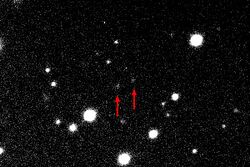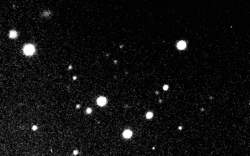Astronomy:2001 QW322
 2001 QW322 imaged by the Canada-France-Hawaii Telescope in 2001 | |
| Discovery[1] | |
|---|---|
| Discovered by |
|
| Discovery site | Mauna Kea Obs. |
| Discovery date | 27 July 2001 |
| Designations | |
| 2001 QW322 | |
| Minor planet category | |
| Orbital characteristics[3] | |
| Epoch 31 May 2020 (JD 2459000.5) | |
| Uncertainty parameter 4 | |
| Observation arc | 18.11 yr (6,613 days) |
| |{{{apsis}}}|helion}} | 44.306 astronomical unit|AU (6.6281 Tm) |
| |{{{apsis}}}|helion}} | 43.319 AU (6.4804 Tm) |
| 45.294 AU (6.7759 Tm) | |
| Eccentricity | 0.02229 |
| Orbital period | 294.92 yr (107,720 d) |
| Mean anomaly | 109.608° |
| Mean motion | 0° 0m 12.031s / day |
| Inclination | 4.7995° |
| Longitude of ascending node | 124.635° |
| 92.373° | |
| Known satellites | 1 (D: 126 km; P: 6280 d)[1] |
| Physical characteristics | |
| Mean diameter | 128+2 −4 km (primary)[1] 126+3 −5 km (secondary)[1] |
| Mass | (2.150±0.184)×1018 kg[1] |
| Mean density | 1±0.2 g/cm3[5] |
| Geometric albedo | 0.093±0.008[1] |
| Absolute magnitude (H) | 7.8[3] |
2001 QW322 is a trans-Neptunian object and binary system of the Kuiper belt, located in the outermost region of the Solar System. The cubewano was discovered at the Mauna Kea Observatories on 27 July 2001, by JJ Kavelaars, Jean-Marc Petit, Brett Gladman, and Matthew Holman. Later in 2001, Kavelaars discovered that it is a binary system. The diameter of the two components are estimated at about 128 kilometers (80 miles) and 126 kilometers (78 miles).[4]
In 2008, work was published showing that the binary has an extraordinarily long orbital period (for a binary trans-Neptunian object, asteroid or minor planet) of about 17 years.[5] The orbital radius is also remarkably high (105,000 to 135,000 km) while the eccentricity is unusually low (< 0.4). All of these parameters are in the extremes of their normal ranges for such objects.[5] The wide spacing and low eccentricity conspire to make the system prone to disruption, and its lifetime is estimated to be in the order of another billion years.[5]
References
- ↑ 1.0 1.1 1.2 1.3 1.4 1.5 Johnston, Wm. Robert (20 September 2014). "Asteroids with Satellites Database – 2001 QW322". Johnston's Archive. http://www.johnstonsarchive.net/astro/astmoons/am2001qw322.html. Retrieved 8 September 2020.
- ↑ Marc W. Buie. "Orbit Fit and Astrometric record for 01QW322". SwRI (Space Science Department). http://www.boulder.swri.edu/~buie/kbo/astrom/01QW322.html. Retrieved 17 February 2018.
- ↑ 3.0 3.1 3.2 "JPL Small-Body Database Browser: (2001 QW322)". http://ssd.jpl.nasa.gov/sbdb.cgi?sstr=2001+QW322. Retrieved 30 March 2016.
- ↑ 4.0 4.1 Johnston, Wm. Robert (18 August 2020). "List of Known Trans-Neptunian Objects". Johnston's Archive. http://www.johnstonsarchive.net/astro/tnoslist.html. Retrieved 8 September 2020.
- ↑ 5.0 5.1 5.2 5.3 Petit, J. -M.; Kavelaars, J. J.; Gladman, B. J.; Margot, J. L.; Nicholson, P. D.; Jones, R. L. et al. (October 2008). "The Extreme Kuiper Belt Binary 2001 QW322". Science 322 (5900): 432–434. doi:10.1126/science.1163148. ISSN 0036-8075. PMID 18927391. Bibcode: 2008Sci...322..432P. https://hal.archives-ouvertes.fr/hal-02374710/file/Petit-etal_2008_Science_preprint_all.pdf.
External links
- The Extreme Kuiper Belt Binary 2001 QW322, Isaac Newton Group of Telescopes, 13 December 2010
- Trans-Neptunian Binaries and the History of the Outer Solar System, Gemini Observatory, 22 August 2011
- A Highly-split Kuiper Belt Pair, Gemini Observatory, 28 October 2008
- Kuiper belt pair sets record for long-distance relationship, New Scientist, 16 October 2008
- 2001 QW322 at the JPL Small-Body Database
 |



